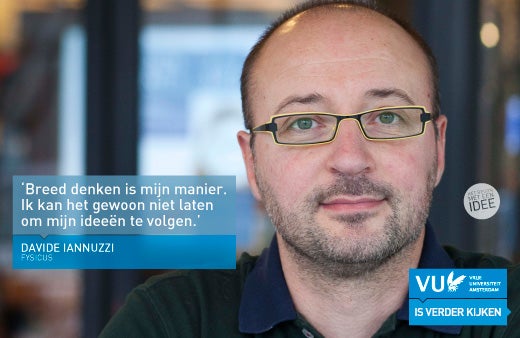It turns out that fundamental research can actually achieve more than the development of potential revolutionary applications for the distant future. Physicist Davide Iannuzzi (1971) needed to solve a technical problem he encountered in his fundamental research. He realized that it must be possible to do the measurements using an optical fibre equippedwith a tiny mechanical beam carved out at its end. The beam remains fixed to one side, creating a kind of moving springboard. As this mechanical beam moves, it causes reflections in the light sent through the fibre. A reading device at the end of the optical fibre records these movements with sub-nanometre accuracy (<10-9 m). The fibre thus becomes a sensor, which can measure temperature, flows, electrical and magnetic fields and much more, and which one can use for nanomicroscopy.
In 2008, the European Research Council (ERC) awarded Iannuzzi with a Starting Grant gravitating around the idea of the fibre-top cantilever. What benefits did the grant bring? “1.8 million euros!”, he laughs. The funding has enabled him to establish his own research line. Iannuzzi set to work on proving that his idea was achievable. “I knew that a machine had just been developed that could be used to carve out a tiny beam on the end of an optical fibre. They had these machines at the University of Twente.” He first put his invention into practice with a team of specialists. “I always say that this and my marriage are the only two things in my life that worked at the first shot.
University Research Chair-hoogleraar
Davide Iannuzzi is one of the five excellent scientists to be appointed as full professor on University Research Chair as of January 1, 2013. The first five URC professors are Davide Iannuzzi, Arianna Betti, Albert Menkveld, Erwin Peterman and Wim van Westrenen. Rector Magnificus Lex Bouter announced their names on October 19 during the Dies Natalis of VU Amsterdam: "We have high expectations of these scientists."
